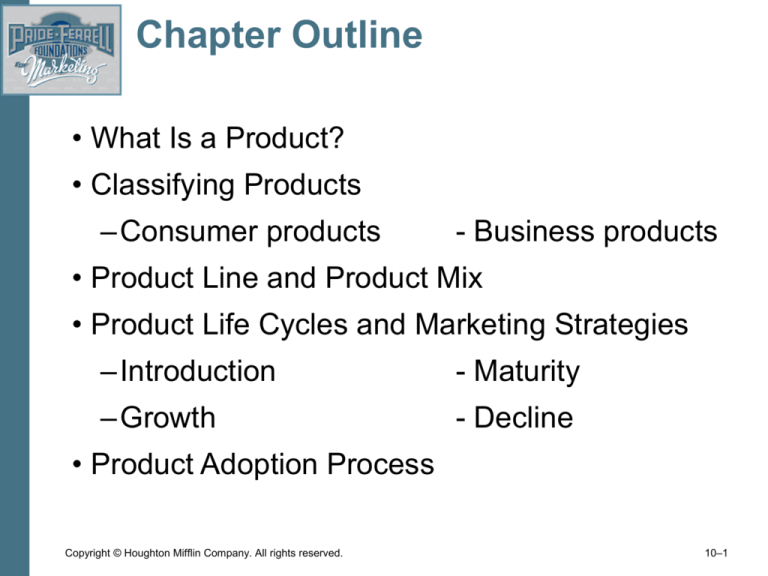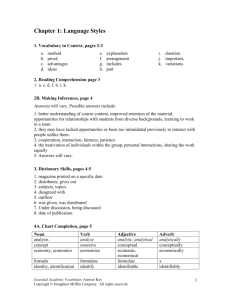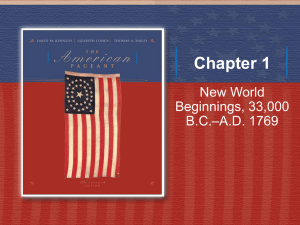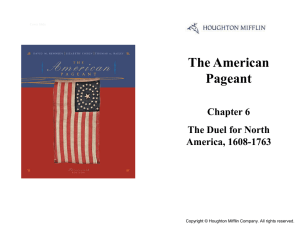
Chapter Outline
• What Is a Product?
• Classifying Products
–Consumer products
- Business products
• Product Line and Product Mix
• Product Life Cycles and Marketing Strategies
–Introduction
- Maturity
–Growth
- Decline
• Product Adoption Process
Copyright © Houghton Mifflin Company. All rights reserved.
10–1
Chapter Outline (cont’d)
• Branding
– Value of branding
– Brand equity
– Types of brands
– Selecting a brand name
– Brand licensing
• Packaging
– Packing functions
- Protecting a brand
- Branding Policies
- Brand equity
- Co-branding
- Major packaging
considerations
– Packaging and marketing
strategy
• Labeling
Copyright © Houghton Mifflin Company. All rights reserved.
10–2
What Is a Product?
• A Product Defined
– A good, a service, or an idea received in an
exchange
– It can be tangible (a good) or intangible (a service or
an idea) or a combination of both.
– It can include functional, social, and psychological
utilities or benefits.
• Why Buyers Purchase a Product
– To get the benefits and satisfaction that they think
the product will provide
– Symbols and cues provided by marketing help
consumers make judgments about products.
Copyright © Houghton Mifflin Company. All rights reserved.
10–3
Classifying Products
• Consumer Products
– Products purchased to satisfy
personal and family needs
• Business Products
– Products bought to use in
an organization’s operations,
to resell, or to make other
products (raw materials
and components)
Copyright © Houghton Mifflin Company. All rights reserved.
10–4
Consumer Products
• Convenience Products
–Relatively inexpensive, frequently purchased
items for which buyers exert minimal
purchasing effort
–Characteristics
• Marketed through many retail outlets
• Relatively low per-unit gross margins
• Little promotional effort at the retail level
• Packaging is important marketing mix element
Copyright © Houghton Mifflin Company. All rights reserved.
10–5
Consumer Products (cont’d)
• Shopping Products
– Items for which buyers are willing to expend
considerable effort in planning and making
purchases
– Characteristics
•
•
•
•
•
•
•
Expected to last a long time; less frequently purchased
Do not have brand loyalty appeal
Require fewer retail outlets
Inventory turnover is lower
Gross margins are higher
More amenable to personal selling
Supported (servicing and promoting the product) by both the
producer and channel members
Copyright © Houghton Mifflin Company. All rights reserved.
10–6
Consumer Products (cont’d)
• Specialty Products
– Items with unique characteristics that buyers are
willing to expend considerable effort to obtain
– Characteristics
• Are preselected by the consumer
• Have no close substitutes or alternatives
• Are available in a limited number of retail outlets
• Purchased infrequently and represent a significant
and expensive investment
• Have high gross margins
and low inventory
turnover
Copyright © Houghton Mifflin Company. All rights reserved.
10–7
Consumer Products (cont’d)
• Unsought Products
– Products purchased to solve a sudden problem,
products of which the customers are unaware, and
products that people do not necessarily think about
buying
– Characteristics
• Speed and problem resolution of the utmost importance
• Price and other features not considered
• No consideration of substitutes
or alternatives
• Purchased infrequently
Copyright © Houghton Mifflin Company. All rights reserved.
10–8
Product Line and Product Mix
• Product Item
Whole
Milk
–A specific version of a product
• Product Line
–A group of closely related product items
viewed as a unit because of
marketing, technical, or
Whole
Milk
end-use considerations
Skim
Milk
2%
Milk
Copyright © Houghton Mifflin Company. All rights reserved.
10–9
Product Line and Product Mix
(cont’d)
• Product Mix
–The total group of products that an
organization makes available to customers
• Width of Product Mix
–The number of product lines a company
offers
• Depth of Product Mix
–The average number of different products in
each product line
Copyright © Houghton Mifflin Company. All rights reserved.
10–10
The Concepts of Product Mix Width and
Depth Applied to Selected United States
Proctor & Gamble Products
FIGURE 10.1
Source: The Procter & Gamble Company. Used with permission.
Copyright © Houghton Mifflin Company. All rights reserved.
10–11
Product Life Cycle
• Product Life Cycle
–The progression of a product
through four stages: introduction,
growth, maturity, and decline.
Copyright © Houghton Mifflin Company. All rights reserved.
10–12
The Four Stages of the Product
Life Cycle
FIGURE 10.2
Copyright © Houghton Mifflin Company. All rights reserved.
10–13
The Product Life Cycle
• Introduction
– The initial stage of a product’s life cycle—its first
appearance in the marketplace—when sales start at
zero and profits are negative
• Growth
– The stage of a product’s life cycle when sales rise
rapidly and profits reach a peak and then start to
decline
•
•
•
•
•
•
More competitors enter the market
Product pricing is aggressive
Brand loyalty becomes important
Gaps in market coverage are filled
Promotion expenditures moderate
Production efficiencies lower costs
Copyright © Houghton Mifflin Company. All rights reserved.
10–14
The Product Life Cycle (cont’d)
• Maturity
– The stage of a product’s life cycle
when the sales curve peaks and starts
to decline and profits continue to fall
• Intense competition
• Emphasis on improvements and differences in competitors’
products
• Weaker competitors lose interest and exit the market
• Advertising and dealer-oriented promotions predominate
• Distribution sometimes expands to the global market
– Strategic objectives for maturity stage
• Generate cash flow
• Maintain market share
• Increase share of customer
Copyright © Houghton Mifflin Company. All rights reserved.
10–15
Product Life Cycle (cont’d)
• Decline
–The stage of a product’s life cycle when sales
fall rapidly
• Pruning items from the product line
• Cutting promotion expenditures
• Eliminating marginal distributors
• Planning to phase out the product
Copyright © Houghton Mifflin Company. All rights reserved.
10–16
Product Adoption Process
• Production Adoption Process
–The stages buyers go through in accepting
a product
Stage
Buyer’s response
Awareness
The buyer becomes aware of the product
Interest
The buyer seeks information and is receptive to
learning about the product
Evaluation
The buyer considers the product’s benefits and
decides whether to try the product
Trial
The buyer examines, tests, or tries the product to
determine if it meets his or her needs
Adoption
The buyer purchases the product and can be expected
to use it again whenever the need for this general type
of product arises
Copyright © Houghton Mifflin Company. All rights reserved.
10–17
Product Adoption Process
(cont’d)
• Categories of Product Adopters
– Innovators
• First adopters of new products
– Early adopters
• Careful choosers of new products
– Early majority
• Those adopting new products just
before the average person
– Late majority
• Skeptics who adopt new products
when they feel it is necessary
– Laggards
• The last adopters, who distrust new products
Copyright © Houghton Mifflin Company. All rights reserved.
10–18
Distribution of Product Adopter
Categories
FIGURE 10.3
Source: Reprinted with permission of The Free Press, an imprint of Simon & Schuster Adult
Publishing Group, from Diffusion of Innovations, Fourth Edition, by Everett M. Rogers.
Copyright © 1995 by Everett M. Rogers. Copyright © 1962, 1971, 1983, by The Free Press.
Copyright © Houghton Mifflin Company. All rights reserved.
10–19
Branding: Key Terms
• Brand
– An identifying name, term, design, or symbol
– One item, family of items, or all items of a seller
• Corvette, Chevrolet, General Motors
• Brand Name
– The part of a brand that can be spoken
– Words, letters, numbers
• Union 76, NBA, 49’ers
• Brand Mark
– The part of a brand not made up of words
– Symbols or designs
• Nike swoosh, Mercedes star, McDonald’s arches
Copyright © Houghton Mifflin Company. All rights reserved.
10–20
Branding: Key Terms (cont’d)
• Trademark
–A legal designation of exclusive use of a
brand
• Coca-Cola®, Hewlett-Packard®
• Trade Name
–Full legal name of an organization
• American Telephone
and Telegraph
Corporation (AT&T)
Copyright © Houghton Mifflin Company. All rights reserved.
10–21
Branding (cont’d)
• Value of Branding
– To Buyers
• Helps speed consumer purchases by identifying specific
preferred products
• Provides a form of self-expression and status
• Evaluates product quality to reduce the risk of purchase
– To Sellers
• Identifies and differentiates a firm’s products from competing
products
• Helps in the introduction of new products
• Facilitates the promotion of all same-brand products
• Fosters the development of brand loyalty
Copyright © Houghton Mifflin Company. All rights reserved.
10–22
Branding (cont’d)
• Brand Equity
–The marketing and financial value associated
with a brand’s strength in a market
• Brand Loyalty
–A customer’s favorable attitude toward a
specific brand
• Brand Recognition
–A customer’s awareness that a brand exists
and is an alternative purchase
Copyright © Houghton Mifflin Company. All rights reserved.
10–23
Branding (cont’d)
• Brand Preference
–The degree of brand loyalty in which a
customer prefers one brand over competitive
offerings
• Brand Insistence
–The degree of brand loyalty in which a
customer strongly prefers a specific brand
and will accept no substitute
Copyright © Houghton Mifflin Company. All rights reserved.
10–24
Major Elements of Brand Equity
FIGURE 10.4
Source: Adapted with the permission of The Free Press, an imprint of Simon & Schuster Adult Publishing Group, from
Managing Brand Equity: Capitalizing on the Value of a Brand Name by David A. Aaker. Copyright © 1991 by David A. Aaker.
Copyright © Houghton Mifflin Company. All rights reserved.
10–25
Top Ten Most Valuable Brands
in the World
Brand
Brand Value (In Billion $)
Coca-Cola
67.4
Microsoft
61.4
IBM
53.8
GE
44.1
Intel
33.5
Disney
27.1
McDonald’s
25.0
Nokia
24.0
Toyota
22.7
Marlboro
22.1
FIGURE 10.2
Source: “The 100 Top Brands,” BusinessWeek, Aug. 2, 2004, p.68. The brand valuations draw upon publibly available information,
which has not been independently investigated by Interbrand. Data: Interbrand Corp., J.P. Morgan Chase & Co., Citigroup, Morgan
Stanley, Business Week.
Copyright © Houghton Mifflin Company. All rights reserved.
10–26
Types of Brands
• Manufacturer Brands
–Brands initiated by producers
• Private Distributor Brands
–Brands initiated and owned
by resellers
• Dealer brands, private brands,
store brands
• Generic Brands
–Brands indicating only the product category
Copyright © Houghton Mifflin Company. All rights reserved.
10–27
Selecting a Brand Name
• The name should
–be easy to say, spell, and recall.
–indicate the product’s major benefits.
–suggest the product’s major uses
and special characteristics.
–be distinctive, setting it apart
from competing brands.
–be compatible with all products in line.
–be designed for use and recognition
in all types of media.
Copyright © Houghton Mifflin Company. All rights reserved.
10–28
Branding Policies
• Individual Branding
–A policy of naming each product differently
–Avoids stigmatizing all products due to a
failed product
• Family Branding
–Branding all of a firm’s products with the
same name
–Promotion of one item also promotes all
other products
Copyright © Houghton Mifflin Company. All rights reserved.
10–29
Brand Extensions
• Using an existing brand name on a new
product in a different category.
• Provides support for new products through
established brand name and image
Copyright © Houghton Mifflin Company. All rights reserved.
10–30
Co-Branding
• Using two or more brands on one product to
capitalize on the brand equity (customer
confidence and trust) of multiple brands
• Brands involved must represent a
complementary fit in the minds of consumers.
Copyright © Houghton Mifflin Company. All rights reserved.
10–31
Packaging
• Involves the development of a container and a
graphic design for a product
• Packaging Functions
–Protect the product from damage
–Offer convenience to consumers
–Prevent waste and make storage easier
–Promote the product by
communicating its features,
uses, benefits, and image
Copyright © Houghton Mifflin Company. All rights reserved.
10–32
Major Packaging Considerations
• Cost of Packaging
–Limited consumer willingness to pay for
better packaging
• Family Packaging
–Similar packaging for all of a firm’s
products or packaging that has
one common design element
A
Copyright © Houghton Mifflin Company. All rights reserved.
A
10–33
Major Packaging
Considerations (cont’d)
• Promotional Role (Informing the Consumer)
–Verbal and nonverbal symbols
–Size, shape, texture, color, and graphics
• Reseller Needs
–Transportation, storage, and handling
Copyright © Houghton Mifflin Company. All rights reserved.
10–34
Packaging and Marketing
Strategy
• Altering the Package
– To update style and to meet increased competition
– To highlight new features
– To take advantage of new packaging materials
– To make the product safer or easier to use
– To reduce packaging costs
• Secondary-Use Packaging
– Reusable packaging adds customer value
• Category-Consistent Packaging
– Packaging reflects customer expectations for the
expected appearance of products in a category
Copyright © Houghton Mifflin Company. All rights reserved.
10–35
Packaging and Marketing
Strategy (cont’d)
• Innovative Packaging
– Unique features or ways of packaging that make a
product more distinct from its competitors
• Multiple Packaging
– Bundling multiple units of a product
together to encourage usage and
to increase demand
• Handling-Improved Packaging
– Packaging that has been changed to facilitate
product handling in the distribution channel
Copyright © Houghton Mifflin Company. All rights reserved.
10–36
Labeling
• Providing identifying, promotional, legal, or other
information on package labels
• Purposes of Labels
– Help identify the product
• Display brand name and unique graphics
– Support promotional efforts for the product
• Coupons, discounts, product features
– Provide legally required labeling information
• Fair Packaging and Labeling Act of 1966
• Nutrition Labeling Act of 1990
– Provide information on product origin
• “Made in the USA”
Copyright © Houghton Mifflin Company. All rights reserved.
10–37



